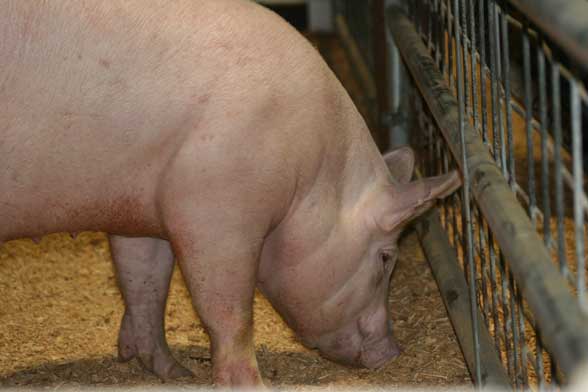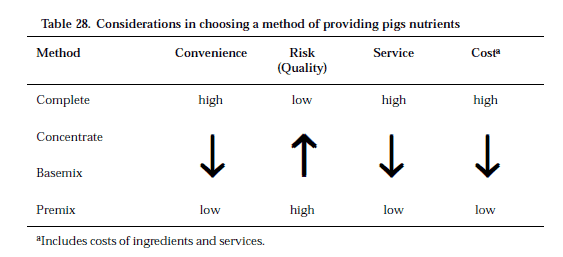Swine Nutrition Guide: Methods of Supplying Nutrients
Methods of Supplying Nutrients -- Making sound decisions about the method(s) used to supply pigs nutrients is an important part of feed program design. However, the terminology used to describe the methods of supplying pigs nutrients often is confused.
There are four basic methods of supplying nutrients to pigs:
1) purchased complete feed;
2) grain plus concentrate or supplement;
3) grain plus soybean meal and basemix; or
4) grain, plus soybean meal, salt, calcium and phosphorus source(s) and premix.

A description of each of these options follows.
Complete feed.
A ready-to-feed product containing ingredients that when combined meet the total nutritional needs of the pig. The feed manufacturer assumes all responsibilities for ingredient quality and mixing errors. The producer is responsible for using the product correctly.
Concentrate or supplement.
A mixture of ingredients formulated to complement nutrients present in grain. When it is correctly mixed with grain, the resulting diet will meet the total nutritional needs of pigs. Typical inclusion rates are 300 to 500 lb/ton for all classes of pigs except starting pigs. The producer's task is to mix the correct ratio of concentrate and grain.
Basemix.
A product generally containing ingredients rich in minerals and vitamins. Basemixes correctly mixed with grain and a protein source(s) will satisfy the total nutritional needs of pigs. Some basemixes may contain crystalline lysine and animal protein products. Typical inclusion rates are 50 to 100 lb/ton, although some basemixes for nursery diets are added at 200 to 400 lb/ton. The producer assumes the responsibility for variation in the quality of the protein source(s) and for correct blending of ingredients.
Premix.
A product containing sources of vitamins and(or) trace minerals. The total nutritional needs of pigs can be met by combining premixes with grain, salt and sources of protein, calcium and phosphorus. Typical inclusion rates are 5 to 10 lb/ton. Premixes are available with trace minerals and vitamins combined or packaged separately. The producer assumes more responsibility for correct diet formulation and preparation and variation in the quality of the protein, calcium and phosphorus sources with this option than with the three other options.
The example diets shown in Tables 19, 21, 22, 24 and 25 are based on a premix program. We do not necessarily endorse a premix program. Our intent is to show common ingredients used to supply the major classes of nutrients necessary in a diet for pigs.
How does one choose which method to use?
One method does not consistently promote better pig performance or a lower cost of gain than another. The major factors we think should be considered in choosing a method of supplying nutrients to pigs are shown in Table 28. Convenience refers to the level of involvement the producer has in making nutritional decisions and feed preparation. Risk is the odds of a diet not containing the intended concentration of nutrients and quality of ingredients. Risk rates the transfer of responsibility from the feed manufacturer to the producer as the producer assumes more or less responsibility for proper quality control and inclusion of nutrient sources in swine diets. Service is the amount of technical advice, farm record keeping and other perks offered. Cost includes costs of ingredients and services such as processing, blending, delivery, technical advice, etc.
Producers who put a high priority on convenience, minimal risk of having feed quality problems, and ample service will want to use complete feeds. However, cost is generally higher to justify the manufacturer's assumption of these risks and services offered. On the other hand, there is less cost in a premix program, but it is a less convenient, higher risk, and lower service-oriented program. The risks associated with feed quality can be managed but it takes a commitment of time and resources. See the sections on Feed Processing and Ingredient Quality for details on preparing quality pig feed. Select the method which provides the best balance of factors you consider important while maintaining a competitive feed cost per unit of gain.

What about mixing feed on the farm?
Choices for producers range from purchasing individual ingredients and manufacturing diets on the farm to purchase and delivery of complete feeds in meal or pellet form. Compare the fixed and operating costs associated with manufacturing feed on the farm to custom rates at local feed mills to decide which option to use. Generally, because of problems with stocking several ingredients and the difficulty in securing and maintaining quality, fresh ingredients such as dried whey and fishmeal, we recommend that most producers purchase complete pelleted feeds for starting pigs weighing less than about 20 to 25 lb. When feed for pigs weighing less than 20 to 25 lb is made on the farm, we recommend it be mixed using a basemix or concentrate that contains many of the specialty ingredients shown in the example diets in Table 19.
This article hasn't been commented yet.


Write a comment
* = required field